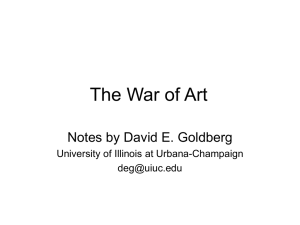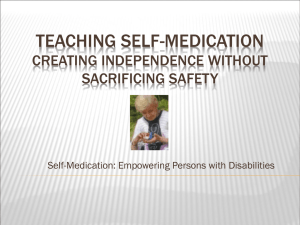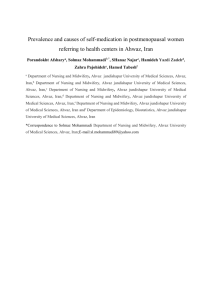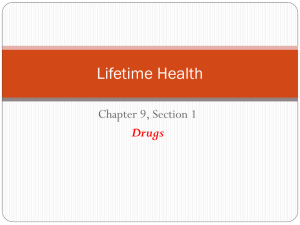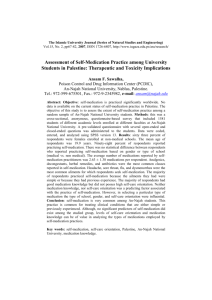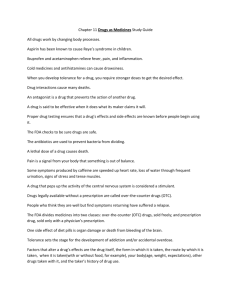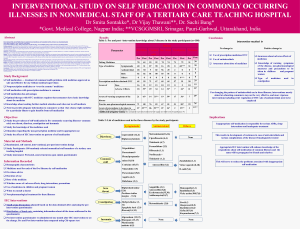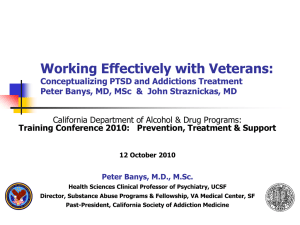self-medication practices among non teaching staff in a tertiary care
advertisement
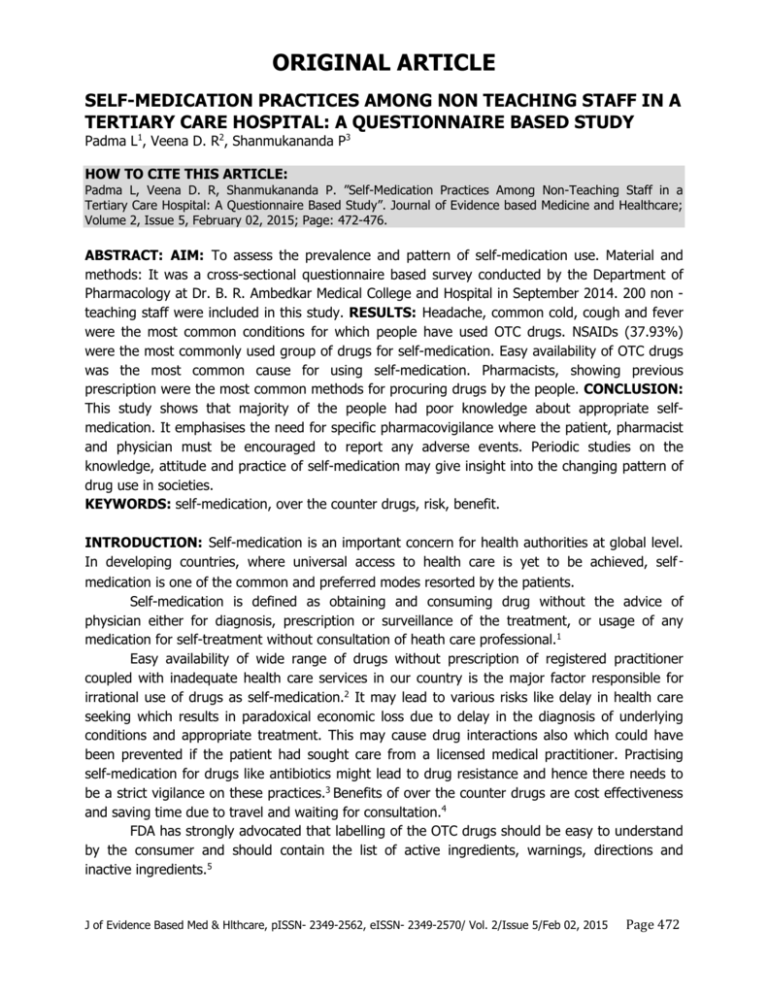
ORIGINAL ARTICLE SELF-MEDICATION PRACTICES AMONG NON TEACHING STAFF IN A TERTIARY CARE HOSPITAL: A QUESTIONNAIRE BASED STUDY Padma L1, Veena D. R2, Shanmukananda P3 HOW TO CITE THIS ARTICLE: Padma L, Veena D. R, Shanmukananda P. ”Self-Medication Practices Among Non-Teaching Staff in a Tertiary Care Hospital: A Questionnaire Based Study”. Journal of Evidence based Medicine and Healthcare; Volume 2, Issue 5, February 02, 2015; Page: 472-476. ABSTRACT: AIM: To assess the prevalence and pattern of self-medication use. Material and methods: It was a cross-sectional questionnaire based survey conducted by the Department of Pharmacology at Dr. B. R. Ambedkar Medical College and Hospital in September 2014. 200 non teaching staff were included in this study. RESULTS: Headache, common cold, cough and fever were the most common conditions for which people have used OTC drugs. NSAIDs (37.93%) were the most commonly used group of drugs for self-medication. Easy availability of OTC drugs was the most common cause for using self-medication. Pharmacists, showing previous prescription were the most common methods for procuring drugs by the people. CONCLUSION: This study shows that majority of the people had poor knowledge about appropriate selfmedication. It emphasises the need for specific pharmacovigilance where the patient, pharmacist and physician must be encouraged to report any adverse events. Periodic studies on the knowledge, attitude and practice of self-medication may give insight into the changing pattern of drug use in societies. KEYWORDS: self-medication, over the counter drugs, risk, benefit. INTRODUCTION: Self-medication is an important concern for health authorities at global level. In developing countries, where universal access to health care is yet to be achieved, self ‑ medication is one of the common and preferred modes resorted by the patients. Self-medication is defined as obtaining and consuming drug without the advice of physician either for diagnosis, prescription or surveillance of the treatment, or usage of any medication for self-treatment without consultation of heath care professional.1 Easy availability of wide range of drugs without prescription of registered practitioner coupled with inadequate health care services in our country is the major factor responsible for irrational use of drugs as self-medication.2 It may lead to various risks like delay in health care seeking which results in paradoxical economic loss due to delay in the diagnosis of underlying conditions and appropriate treatment. This may cause drug interactions also which could have been prevented if the patient had sought care from a licensed medical practitioner. Practising self-medication for drugs like antibiotics might lead to drug resistance and hence there needs to be a strict vigilance on these practices.3 Benefits of over the counter drugs are cost effectiveness and saving time due to travel and waiting for consultation.4 FDA has strongly advocated that labelling of the OTC drugs should be easy to understand by the consumer and should contain the list of active ingredients, warnings, directions and inactive ingredients.5 J of Evidence Based Med & Hlthcare, pISSN- 2349-2562, eISSN- 2349-2570/ Vol. 2/Issue 5/Feb 02, 2015 Page 472 ORIGINAL ARTICLE There are only few studies done in our country at the community level to assess the magnitude of self-medication practices. Hence this study was undertaken to assess the prevalence and pattern of self-medication use. MATERIAL AND METHODS: It was a cross-sectional questionnaire based survey conducted by the Department of Pharmacology at Dr. B. R. Ambedkar Medical College and Hospital in September 2014 to assess the prevalence and pattern of self-medication use among the nonteaching staff. 200 non-teaching staff in Dr. B. R. Ambedkar Medical College and Hospital were chosen and asked to fill the questionnaire. A self-developed, pre validated questionnaire consisting of 16 items in the form of closed and open-ended questions was used. Attempts were made to address the prevalence of self-medication practices, most likely reason, types of symptoms and sources of information. The study was approved by the Institutional Ethics Committee. Data was analysed using descriptive statistics. RESULTS: NUMBER OF PERCENTAGE SUBJECTS (n) (%) Headache 70 35 Cold and cough 61 30.5 Fever 55 27.5 Diarrhoea 07 3.5 Pain abdomen 04 2 Vomiting 03 1.5 CONDITION Table 1: Indications for self-medication Reason Ease and convenience Time constraints Minor illness Quick relief Economical Non availability of a doctor N % 62 31 46 23 37 18.5 31 15.5 19 9.5 05 2.5 Table 2: Reasons for self-medication Drug group NSAID’s Antihistamines Antacids and H2 antagonists Antimotility n 99 40 40 35 J of Evidence Based Med & Hlthcare, pISSN- 2349-2562, eISSN- 2349-2570/ Vol. 2/Issue 5/Feb 02, 2015 Page 473 ORIGINAL ARTICLE Antitussives Antiemetics Antibiotics Mutivitamins 17 13 12 05 Table 3: Common group of drugs used as OTC Factors n % Alcoholic 98 49 smoker 87 43.5 Chronic illness 11 5.5 Awareness about drug interactions 10 5.0 Knowledge of drug profiles 0 0 Table 4: Factors which may lead to adverse events Fig. 1: Number of drugs consumed per day Fig. 2: Sources for self-medication J of Evidence Based Med & Hlthcare, pISSN- 2349-2562, eISSN- 2349-2570/ Vol. 2/Issue 5/Feb 02, 2015 Page 474 ORIGINAL ARTICLE DISCUSSION: Headache (37%), common cold and cough (30.5%) followed by fever (27.5%) were the most common conditions for which people have used OTC drugs. These findings are comparable with another study.6 Some chronic conditions like diabetes mellitus type 2 and arthritis were also managed by self-medication. NSAIDs (37.93%) were the most commonly used group of drugs for self-medication in this study. Other studies also had opined similar findings.7,8 Easy availability of OTC drugs was the most common cause for using self-medication. Poly pharmacy was seen in 17.2%. Pharmacists, showing previous prescription were the most common methods for procuring drugs by the people. 49 % respondents committed they were alcoholic and 43.5 % were smokers. Awareness about drug interactions of OTC drugs with alcohol, smoking and chronic diseases was only 5%. None of them had knowledge of drug profiles. CONCLUSION: This study shows that majority of the people had poor knowledge about appropriate self-medication. It is necessary to create awareness by educating the public about the indiscriminate use of drugs. A statutory drug control must be implemented to restrict the availability of drugs to the public without a prescription by a registered medical practitioner. It emphasizes the need for specific pharmacovigilance where the patient, pharmacist and physician must be encouraged to report any adverse events. Periodic studies on the knowledge, attitude and practice of self-medication may give insight into the changing pattern of drug use in societies. REFERENCES: 1. Montastruc JL, etal. Pharmacovigilance of self-medication. Therapies, 1997; 52 (2): 105110. 2. Shankar PR, Partha P, etal. Self-medication and non-doctor prescription practices in Pokhara valley, Western Nepal; a questionnaire based study. BMC Fam Pract 2002; 3: 17. 3. Ganguly NK, Arora NK, etal. Global antibiotic resistance partnership (GARP): India Working Group. Rationalizing antibiotic use to limit antibiotic resistance in India. Indian J Med Res, 2011; 134: 281‑94. 4. Rohit KV, Lalit M, etal. Evaluation of self-medication among professional students in North India: proper statutory drug control must be implemented. Asian Journal of Pharmaceutical and Clinical Research, 2010; 3 (1): 60-64. 5. Food and Drug Administration (FDA). Regulation of Nonprescription Products. http://www.fda.gov/AboutFDA/CentersOffices/CDER/ucm093452.htm. 6. Kalaiselvi Selvaraj, Ganesh KS, etal. Prevalence of self ‑ medication practices and its associated factors in Urban Puducherry, India. Perspectives in Clinical Research, 2014; 5 (1): 32-36. 7. Keche Y, Yegnanarayan R, etal. Self-medication pattern in rural areas in Pune, India. Int. J Med Public Heal, 2012; 2:7. 8. Sharma R, Verma U, etal. Self-medication among urban population of Jammu city. IJP, 2005; 37 (1): 37-45. J of Evidence Based Med & Hlthcare, pISSN- 2349-2562, eISSN- 2349-2570/ Vol. 2/Issue 5/Feb 02, 2015 Page 475 ORIGINAL ARTICLE AUTHORS: 1. Padma L. 2. Veena D. R. 3. Shanmukananda P. PARTICULARS OF CONTRIBUTORS: 1. Professor & HOD, Department of Pharmacology, Dr. B. R. Ambedkar Medical College. 2. Associate Professor, Department of Pharmacology, Dr. B. R. Ambedkar Medical College. 3. Professor, Department of Pharmacology, Dr. B. R. Ambedkar Medical College. NAME ADDRESS EMAIL ID OF THE CORRESPONDING AUTHOR: Dr. Veena D. R, Associate Professor, Department of Pharmacology, Dr. B. R. Ambedkar Medical College, K. G. Halli, R. T. Nagar, Bangalore-45. E-mail: veena.dr@gmail.com Date Date Date Date of of of of Submission: 09/01/2015. Peer Review: 10/01/2015. Acceptance: 20/01/2015. Publishing: 27/01/2015. J of Evidence Based Med & Hlthcare, pISSN- 2349-2562, eISSN- 2349-2570/ Vol. 2/Issue 5/Feb 02, 2015 Page 476
